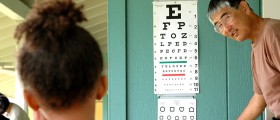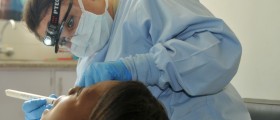
LASIK, which is a short name for laser-assisted in situ keratomileusis, is a type of refractive eye surgery used to correct problems in vision such as myopia, hyperopia and astigmatism. The procedure is similar to other corrective procedures, but it provides one important advantage: faster patient’s recovery. The surgery is performed using a laser. This is the more commonly performed type of refractive surgery procedure as it offers a relative lack of pain after the surgery, and the targeted vision quality is normally achieved by the very next day.
LASIK technique
The goal of the LASIC surgery is to reshape the cornea, a semi-transparent part of the eye covering the iris and pupils. The correction can be performed using a microkeratome, a small instrument equipped with a disposable blade that surgeons use to cut the cornea, or with a laser. During the procedure surgeon will remove some corneal tissue and reshape the cornea. Laser ultraviolet light beam is very accurate and provides brilliant results. The goal is to reshape the cornea in such a way that it works better while focusing the light into the eye.
Who is the right candidate?
LASIK surgery is not suitable for all of the patients. The ophthalmologist will follow certain guidelines when considering one’s candidacy for LASIK. The most important limitation is that the patient’s eyes must be healthy. Patient will not be suitable for LASIK if any other eye problem (dry eyes, eye injury, conjunctivitis) is present. Only adult patients can have LASIK surgery. Moreover, patient should have a stable vision, without changes, for at least a year, before being considered for LASIK. Pregnant women and people with degenerative or autoimmune diseases are not suitable for this type of surgery.
Preparations for LASIK
Before the procedure, doctor will perform a complete eye check. If the eyes are dry, doctor will first prescribe a therapy to clear this condition before performing LASIK. Doctor will use a corneal topographer to measure the curvature of the eye and create a map for future surgery. Patients will have to restrain from wearing contact lenses 5 to 21 days before surgery.
After the surgery
Postoperative care usually involves the use of antibiotic and anti-inflammatory eye drops for a couple of weeks following the surgery. Patients may also be required to moisturize the eyes with artificial tears and protect them with darkened shields from bright lights.
The average LASIK cost
Based on the survey of refractive surgeons conducted during the 2010, the average LASIK costs are $2,150 for all laser-based vision correction procedures, $1,580 for non-customized LASIK, and $2,170 for wavefront-guided LASIK.

















Your thoughts on this
Loading...